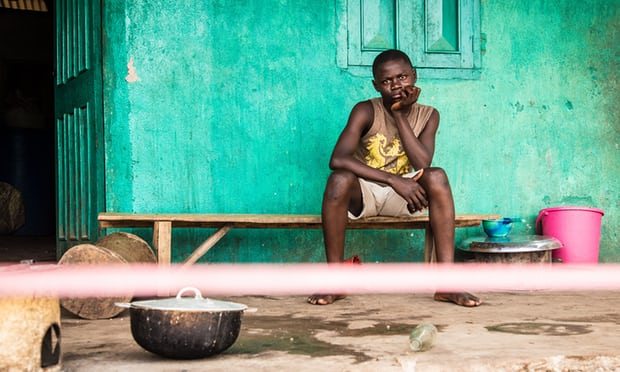
Sierra Leone is the most dangerous country in the world to be aged between 15 and 29, analysis of WHO data shows. Photograph: Michael Duff/AP
Violence, preventable diseases and traffic accidents are to blame for a widening of the youth mortality gap between the developed and developing world, according to a new Guardian analysis of the most recent World Health Organisation (WHO) data.
The most dangerous country in the world to be a young person (defined as aged between 15 and 29) is Sierra Leone, with one youth in every 150 there estimated to have died in 2015. Its youth mortality rate per 100,000 (671) is almost 100 people higher than the next country on the list, war-torn Syria (579).
Cyprus is the safest of the 184 countries analysed, with a death rate of almost one in every 4,762 youths, while Denmark, the fifth safest, halved its number of young deaths between 2000 and 2015. The United Kingdom (one in every 3,030 young people) is ranked just outside the top 10 safest countries, behind Israel.
The analysis finds that young people in the United States are six times as likely to be murdered as their British counterparts. They are also more than three times as likely to be killed in a car crash, and twice as likely to commit suicide or overdose on drugs. Self-harm is the most common cause of death for young people in the UK.
Liberal drug policies in the Netherlands may be responsible for a rate of drug-related deaths almost exactly ten times lower than in the US.
Globally, the mortality rate for young people decreased 21% between 2000 and 2015, with HIV-related deaths in particular falling significantly. Yet the gap between developing and developed countries has widened in that period, from 2.2 up to 2.4 times higher.
The explanation is that, while youth mortality rates are falling fastest in the world’s most and least developed countries, the decline is considerably slower in “mid-tier” countries such as Brazil and Venezuela, as defined by the Human Development Index.
Syria is the only non-African country to feature among the 25 countries with the highest youth mortality rates. Despite that, considerably more young people died as a result of violence in Brazil in 2015 than in Syria.
In Nigeria, the fourth worst-performing country, approximately 235,000 youths are estimated to have died in 2015. In absolute terms, this was the second highest number of young deaths in the world after India, whose population is seven times greater.

Road accidents
Road accidents are the most common cause of death of young people throughout the world. The WHO estimates that 350,000 young people died in 2015 as a result of traffic-related injuries. While the problem affects both developed and developing countries, the data reveals markedly different trends.
For example, while traffic-related deaths in Ecuador increased by 110% from 2000 to 2015, Spain managed to reduce its traffic-related deaths by 85% in the same period.
In Luxembourg, one of the safest countries in the world, 46% of youth mortality is caused by road accidents, but the related mortality rate is just under 10 per 100,000 – almost half the average global rate. In Venezuela, traffic injuries cause 29% of young deaths, but they kill 70 out of 100,000 young people every year – the highest rate in the world. Besides Venezuela, every other country in the top 20 for traffic-related deaths is in Africa.
Violence
The average global mortality rate related to personal violence has decreased by about 14%, from 12 to 10 young deaths per 100,000. But it remains very high in a few Latin American countries such as Brazil, El Salvador, Colombia, Honduras and Venezuela.
In El Salvador in Central America, the rate reached 104 per 100,000 in 2015. That’s almost 10 times as high as the global average, and nearly 500 times higher than Japan, one of the countries with the lowest levels of reported violence in the world.
Organised crime, high levels of inequality, inadequate law enforcement and the strategic position of these countries on the international drug market all contribute to making violence a persistent problem in the region.
About 33,000 young people are estimated to have died in Brazil in 2015 as a result of the region’s epidemic of violence. That’s considerably higher than the number of people in this age range killed in Syria in the same year – 24,000.
The youth mortality rate for some of the countries in the region is as high as far less developed countries. In Brazil, it stands at 156 per 100,000, higher than India (153), while in Venezuela the rate (244) is similar to Niger (248).
Self-harm
While the number of deaths from self-harm decreased during the period, the WHO estimates that 220,000 people took their lives in 2015, making it the second most common cause of death among young people.
Countries as diverse as Sri Lanka, Russia, New Zealand and Argentina have self-harm-related mortality rates over 20 per 100,000 for this age group, while nearly half of all young deaths in Iceland in 2015 were due to self-harm.
It is also the most common cause of death for young people in the UK – although the country has a relatively low rate when compared to the rest of the world, at six per 100,000.
Preventable diseases
From 2000 to 2015, deaths in African countries related to pregnancy, tuberculosis, parasitical diseases – including malaria – and diarrhoea fell by around a third. These deaths are easily preventable with adequate healthcare and sanitation, and seldom occur in western Europe. However, they are still some of the most common causes of young deaths in many African countries.
In Sierra Leone, 74 out of 100,000 people died as a result of pregnancy. The global average is less than nine per 100,000. About 1,800 young people died in Somalia due to diarrhoea, a cause of death that’s been almost completely eradicated in more than 50 countries.
The number of HIV-related deaths has halved in ten years, but still takes a heavy toll in countries such as Lesotho, where it kills 218 of every 100,000 young people.
guardian.co.uk © Guardian News & Media Limited 2010
Published via the Guardian News Feed plugin for WordPress.







